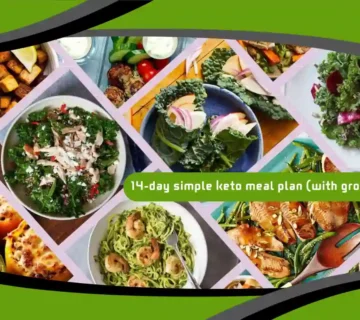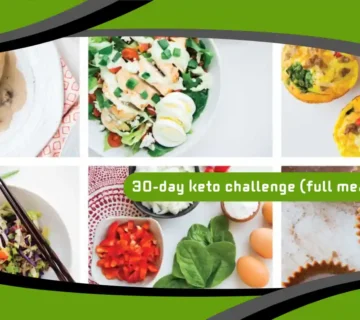A high-protein keto meal plan offers an excellent way to boost muscle mass, promote fat loss, and keep your metabolism revved up while adhering to the principles of the ketogenic diet. The ketogenic diet, known for its high-fat, low-carb approach, can be further enhanced with a higher protein intake, making it an ideal choice for those looking to optimize their body composition. Whether you’re an athlete, bodybuilder, or just someone looking to lose weight and improve health, a high-protein keto meal plan can support your goals by ensuring you’re getting the nutrients your body needs without spiking insulin levels.

Understanding the Keto Diet’s Role in Fat Loss
The ketogenic diet places your body into a state of ketosis, where it burns fat for energy instead of carbohydrates. By drastically reducing your carb intake, you force your body to utilize fat as the primary fuel source. This not only helps with fat loss but also stabilizes blood sugar and insulin levels, leading to improved overall health. High-protein keto meal plans enhance this process by maintaining muscle mass while still promoting fat loss.
Benefits of Incorporating Protein into Your Keto Diet
Adding more protein to your keto meal plan supports muscle repair and growth, which is essential, especially during weight loss phases. Protein also increases satiety, helping you feel fuller for longer periods, which can lead to reduced calorie intake and better weight management. Additionally, protein is essential for the production of enzymes, hormones, and other vital components of your body.
Watch also: Keto and Intermittent Fasting Combined: The Ultimate Fat-Burning Plan Backed by Science
The Importance of Choosing High-Quality Protein Sources
Not all proteins are created equal. High-quality protein sources, such as lean meats, fish, eggs, and certain dairy products, are essential to maintaining health on a high-protein keto meal plan. These sources are rich in essential amino acids, which are crucial for building and repairing tissues, including muscles. Choosing high-quality proteins ensures you’re getting the most out of your meals.
How Much Protein Should You Consume on a High-Protein Keto Meal Plan?
On a typical keto diet, protein intake is usually moderate, making up around 20-25% of your total daily calories. However, a high-protein keto meal plan may increase protein intake to 30-40%. This ensures that while your body is in ketosis, it also gets enough protein to maintain lean muscle mass. The exact amount will depend on factors such as activity level, age, and specific goals.
Low-Carb, High-Protein Foods for Your Keto Meal Plan
To maintain ketosis while increasing protein, it’s important to choose foods that are both low in carbs and high in protein. Some excellent options include lean cuts of beef, chicken breast, turkey, salmon, tuna, and eggs. Non-starchy vegetables like spinach, kale, and broccoli can complement these proteins and provide important micronutrients without adding excessive carbs.
Creating a Balanced High-Protein Keto Meal Plan
A balanced high-protein keto meal plan should include a variety of protein sources, healthy fats, and low-carb vegetables. Start by calculating your macronutrient needs, ensuring you get enough protein while maintaining a low-carb intake to stay in ketosis. A typical meal might include grilled chicken with avocado and a side of sautéed spinach or a piece of salmon with a green salad dressed in olive oil.
Sample Breakfast Options for High-Protein Keto
A high-protein keto breakfast might include scrambled eggs with avocado and turkey bacon, or a protein shake made with unsweetened almond milk, protein powder, and a handful of spinach. These meals provide a solid protein boost while keeping carbs low, ensuring that you start the day in ketosis and feeling satisfied.
Protein-Rich Lunch Ideas for Your Keto Diet
For lunch, try grilled chicken or turkey paired with a side of cauliflower rice and roasted vegetables. A keto-friendly salad with grilled shrimp, mixed greens, and an olive oil-based dressing is another excellent option. These meals offer a combination of high protein and healthy fats to fuel your body through the afternoon.
High-Protein Keto Dinner Recipes
For dinner, opt for protein-rich options like steak, salmon, or a baked chicken thigh. Pair it with roasted non-starchy vegetables like zucchini or asparagus and a healthy fat source like olive oil or butter. A hearty meat-based stew or a grilled salmon fillet with sautéed kale are also satisfying and nutritious dinner choices.
Snacks for a High-Protein Keto Diet
While following a high-protein keto plan, you’ll want to include snacks that are low in carbs but packed with protein. Some options include hard-boiled eggs, jerky, or a handful of nuts like almonds or macadamia nuts. Greek yogurt (unsweetened) with chia seeds or protein bars made with keto-friendly ingredients are also good snack choices.
How to Track Your Protein Intake
Tracking protein intake is key to making sure you’re hitting your goals. Apps like MyFitnessPal or Cronometer can help you log your meals and track your macronutrient ratios. Aim to consume protein with each meal to meet your daily target, but be mindful not to overconsume, as excess protein can be converted into glucose through gluconeogenesis.
Watch also: How to Create Your Own Keto Meal Plan: Expert Guide to Custom Low-Carb Meals
Managing Ketosis with High Protein
While protein is essential, consuming too much can kick you out of ketosis, as your body may convert excess protein into glucose. It’s important to find the right balance between protein and fat intake. Monitor your body’s response by testing for ketosis with strips or a blood ketone meter to ensure you’re staying in fat-burning mode.
Exercise and a High-Protein Keto Meal Plan
Exercise plays a crucial role in the effectiveness of a high-protein keto meal plan. Weight training or resistance exercises combined with a high-protein diet helps build and maintain lean muscle mass. Additionally, exercising in ketosis can enhance fat loss while preserving muscle, making it an effective approach for body composition goals.
The Role of Healthy Fats in a High-Protein Keto Meal Plan
While protein is emphasized in this meal plan, fats remain a vital part of a keto diet. Healthy fats like avocados, olive oil, and coconut oil should still make up the majority of your calorie intake. These fats help support ketosis, keep you feeling full, and provide essential fatty acids for optimal health.
Hydration and Electrolytes on a High-Protein Keto Diet
Staying hydrated is essential on any keto diet, but it becomes even more important when increasing protein intake. Protein metabolism requires water, and dehydration can lead to issues like muscle cramps or fatigue. Ensure you are drinking plenty of water throughout the day and replenishing electrolytes with foods like spinach or supplements to prevent imbalances.
Potential Challenges of a High-Protein Keto Meal Plan
While the high-protein keto meal plan can be incredibly effective, there are potential challenges to be aware of. Overconsumption of protein can interfere with ketosis, and some individuals may experience digestive issues if they are not used to higher protein intake. It’s important to listen to your body and adjust your plan as needed.
Tips for Success with Your High-Protein Keto Meal Plan
To make the most out of your high-protein keto meal plan, consider meal prepping, using high-quality protein sources, and tracking your progress. Stick to whole foods, prioritize variety, and balance your meals with healthy fats and vegetables. A well-planned approach will help you stay on track and achieve your nutritional goals.
Adjusting Your High-Protein Keto Plan for Long-Term Success
Sustainability is key to long-term success on any diet. Once you’ve adapted to your high-protein keto meal plan, focus on consistency and making adjustments as needed based on your progress. Regularly evaluate your goals, and if necessary, tweak your macronutrient ratios or meal timing to keep progressing.
Conclusion: Achieving Optimal Health with a High-Protein Keto Meal Plan
A high-protein keto meal plan offers a powerful approach to achieving your health and fitness goals. By incorporating high-quality protein sources into your meals, you can promote muscle growth, enhance fat loss, and improve your overall well-being while staying in ketosis. With careful planning and attention to balance, this diet can be both sustainable and effective, helping you achieve lasting results.
Watch also: Holiday Keto Meal Plan: Low-Carb Christmas & Thanksgiving Recipes to Stay in Ketosis



No comment